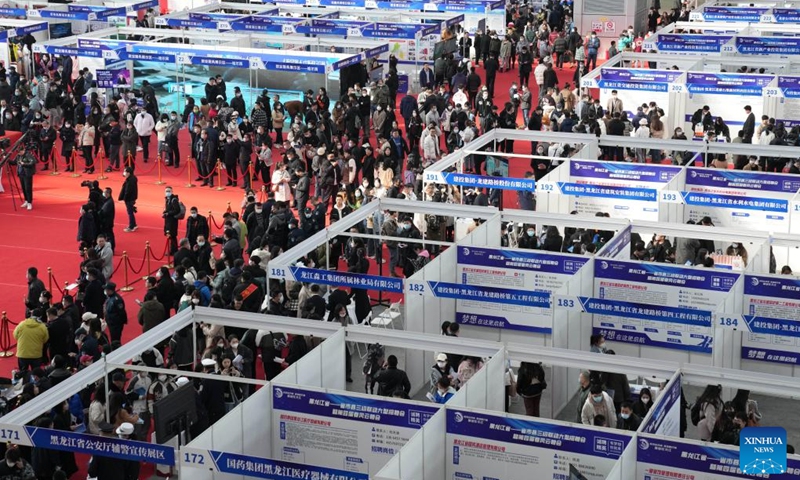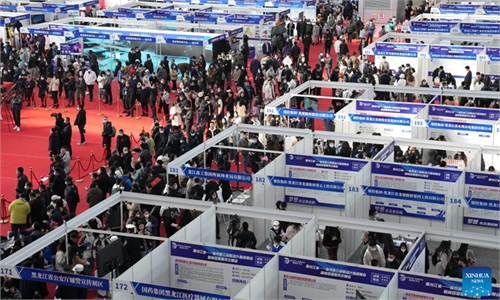
This photo taken on March 18, 2023 shows a view of a job fair in Harbin, northeast China's Heilongjiang Province. Photo:Xinhua
Chinese education authorities have started a 100-day sprint by releasing a slew of practical policies to expand employment for graduating students this year in the face of a sluggish job market.
According to the Xinhua News Agency on Monday, the sprint, led by the Ministry of Education (MOE) operating from May until August this year, is designed to expand the job market, provide targeted employment guidance, strengthen employment support for key groups and improve employment monitoring mechanisms. The percentage of unemployed 16- to 24-year-olds reached its highest level in April.
The MOE told universities nationwide to continue to carry out the activities of enterprises on campus, make full use of the "internet + employment" resources, and provide job information for graduates who have yet to find jobs.
The job market has been sluggish over the past few years due to the prolonged impact of the COVID-19 epidemic, and new graduates entering the job market in 2023 still have not fully escaped these shocks.
A graduate student surnamed Zhang from Jilin University in Changchun, Northeast China's Jilin Province, told the Global Times on Tuesday that he and his classmates feel that the overall employment environment is not easy this year.
"For some of the more basic positions, it's easier to find jobs with the right professional skills. But positions with higher salaries usually have super-high requirements, which are difficult for ordinary graduates to reach."
He also said that the school's departments are actively organizing job fairs, providing relevant lectures and working to match more suitable positions and students with each other.
The employment dilemma faced by graduates is confirmed by the latest statistics. Data released by the National Bureau of Statistics (NBS) on Tuesday showed that the national surveyed unemployment rate for people aged 16 to 24 was 20.4 percent in April, exceeding 20 percent for the first time.
NBS spokesperson Fu Linghui said that the structural problems of employment are still relatively prominent, as the youth unemployment rate is still high. As relevant departments are now actively introducing targeted policies to alleviate those problems, he believed that the employment situation of young people will gradually improve.
In 2023, China will have 11.58 million fresh college graduates, a record high.
China's unemployment problems faced by the young generation originate from two types of unemployment - frictional unemployment and structural unemployment, and the causes are different, Xiong Bingqi, director of the 21st Century Education Research Institute, told the Global Times on Tuesday.
In response to frictional unemployment, the main thing should be to strengthen employment guidance services for young people, provide them with adequate employment information services, and guide them to form reasonable employment expectations, which is what various departments are doing and what the new policies are dedicated to solving.
For example, colleges and universities should extend employment guidance and services for college graduates to one year after graduation, or even longer, Xiong said.
On this issue, the MOE also pointed out that, in view of the fact that most of the graduates had relatively few internships and chances to practice due to the COVID-19 epidemic, universities and colleges should carry out targeted employment guidance and take effective measures to guide graduates to actively seek early employment.
For structural unemployment, it is necessary to promote education reform, optimize the structure of talent training and improve the quality of training according to the changes in demand brought by social development, said Xiong.
On the whole, China's job market is picking up. Data show that in April, the national urban surveyed unemployment rate was 5.2 percent, down 0.1 percentage points from the previous month, and down for two consecutive months. It was also close to the statistical level before the 2019 epidemic.


